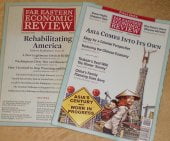The Far Eastern Economic Review has printed its last issue. The title was founded in Hong Kong in 1946, but several distinct publications used the name in succession. The weekly I started reading in the 1980s was knowledgeable and sometimes so in-depth as to be barely penetrable to any but the most devoted follower of Asian political and economic affairs. Where an averagely dutiful student of the region would find one or two columns enough – on the political situation in Laos, say, or a business deal in Korea – FEER would deliver three fact- and analysis-filled pages. You would get a picture if you were lucky.
In the late 1980s, Dow Jones took full ownership. Outsiders could infer from grumbles and goings-on that the new American overseers were culturally mismatched with the old-school British, Australian and Indian reporters.
In the 1990s, Karen Elliott House, assistant (and wife) of Dow Jones boss Peter Kann, would swoop into town from time to time to sack people and beat a more Wall Street Journal type of ideology into the editorial stance. FEER started to show unmistakable signs of dumbing down. To the old Asia hands who had worked at legendary editor Derek Davies’s regional journal of record, this was the beginning of the end, and part of the evil Dow Jones plan.
It was true that the magazine competed with the WSJ’s up-and-coming Asian edition, so DJ had an interest in differentiating it (and in not selling it to a rival publisher). But advertising space was already getting harder to sell, as all sorts of new media appeared in various languages around the region, and later on-line. Readership was also already declining; as we shall see, this was arguably caused by a cultural trend no owner or editor could have overcome.
The last straw for me, and apparently many others, was a glossy multi-page feature on our friend the chilli pepper and its role in Asian people’s lives. I don’t recall whether the article contained any recipes, but I don’t think it was that useful or factual.
Five years ago to the month, issue No 1, Vol 168 of FEER came out. Except it wasn’t FEER. What appeared was a monthly journal in paperback format published by the same part of DJ that produced the Asia Wall Street Journal. Unlike the 1980s FEER, with its network of correspondents and reporters, it had nothing but a tiny in-house staff. Subsequent editions revealed a focus that was largely on policy, and contributors who were predominantly dry, obscure academics and – even worse – self-important, blather-ridden conference-whores like former Philippines President Fidel Ramos, via ghost-writers.
That could have been the end of the story. But against the odds – given that DJ didn’t seem to take it very seriously – the monthly FEER perked up and started to get material from authoritative people in journalism, finance and elsewhere with interesting things to say. In 2006 it attained the ultimate accolade for a publication worth reading by being banned in Singapore. This month’s last-ever issue was one of the best.
The crusty old denizens of the classic pre-90s version of FEER will never forgive DJ for deliberately killing the organ that carried much of their life’s best work. They will doubtless be infuriated by an alternative view of the magazine’s demise offered in the final issue (by someone from the DJ side of the fence).
According to this analysis, FEER belonged to a milieu from a bygone age:
For several decades spanning the era of late colonialism in the 1950s to the spread of intense globalization in the early 1990s, a unique cultural niche sprang up in Asia. It was a transitory and transnational community peopled by Western expats—diplomats, executives, scholars and travelers—and local Asian elites in business, government and education who were themselves products of the colonial era.
It is not just that the younger generations have a much broader range of international and local media to choose from; they have a different way of seeing things from the fundamentally ‘British Commonwealth’ (not that he says that) outlook of the old hands. FEER, according to this analysis, catered for the expats in safari suits who had long liquid lunches on Saturdays before heading back to close the office, and the local civil servants who couldn’t stop writing memos in English after independence.
Having witnessed their twilight days, I think he has a point.

The main thing: How many millions will my copies of the first and last monthly FEER be worth on eBay in 20 years?
